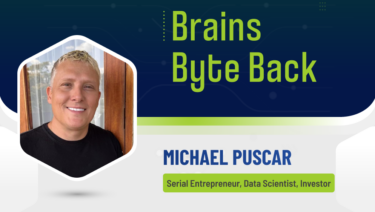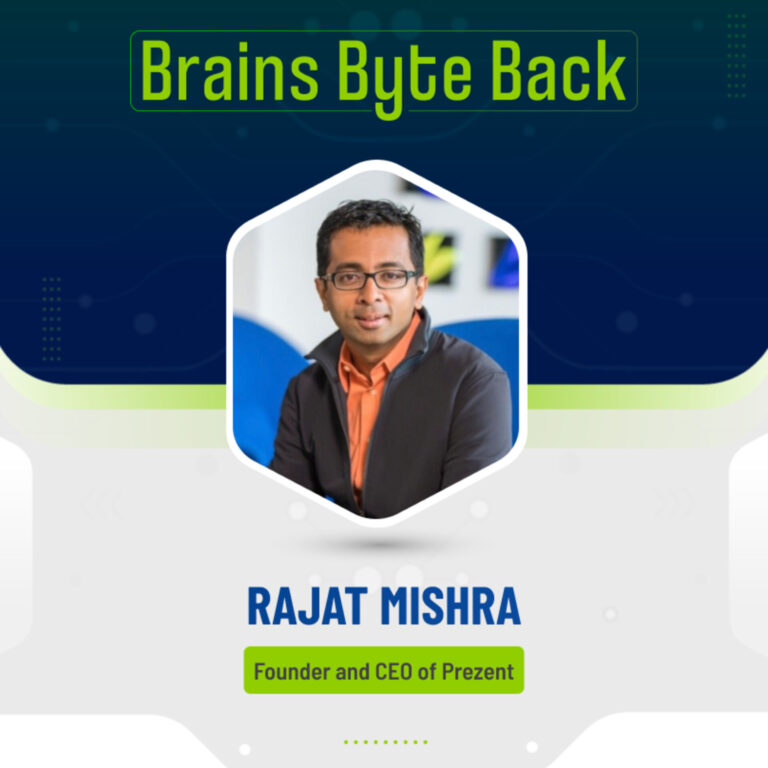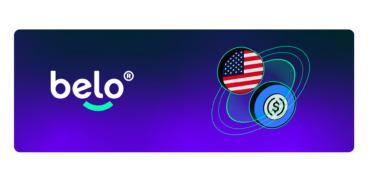In this episode of Brains Byte Back, we’re joined by Rajat Mishra, Founder and CEO of Prezent.ai, an enterprise business communication platform.
He starts by sharing that he had a stutter as a child growing up in India, and through that experience, he realized that life can be hard if you don’t communicate well. He builds on this by explaining that his educational and enterprise career journey introduced him to a world of intelligent and capable people whose career growth was stumped because they couldn’t effectively communicate their ideas.
This led him to quit his six-figure job as the senior vice president at Cisco to pursue his growing vision of democratizing business communications. He embarked on this journey alongside his wife, and they successfully obtained funding of up to 20 million to build Prezent.
Rajat then explains that Prezent is an intelligent platform that automates four specific business communication needs. He discusses the nuances and layers of what makes business communication great, including understanding the audience, structuring the business storyline, providing insight into the industry, and touching on how their AI agent, ASTRID, guides you through the process.
He adds that when they started the company in 2021, they started with the idea of using AI from the get-go. It was still a new concept to many of his clients at the time. They used the emerging technology to first focus on hyper personalization based on communication styles. But following the launch of Chat GPT, they’ve been able to fine-tune Astrid, their compound AI system, to better serve their customers.
Rajat explains in detail what he means by their mission statement of democratizing business communication. It’s based on the idea of sharing the power of great business communication with every company member. Pointing out how middle management historically struggles with assistance in this area.
We talk about the idea of embracing AI as we step into the future and the interesting new features on the horizon for Prezent with the help of emerging technology, including verbal communication assistance. We touch on the three differences in how the enterprise space is reacting to this forward leap, including a very small percentage of companies that are so hesitant that they’ve blocked .ai domain names.
He adds that he extends empathy toward understanding every company’s approach to AI and stresses that leaders in the space are responsible for educating safe use and growth of the technology, not just monetizing it.
You can listen to the episode below, or on Spotify, Anchor, Apple Podcasts, Breaker,, Google Podcasts, Stitcher, Overcast, Listen Notes, PodBean, and Radio Public.
Transcript:
Rajat Mishra:
My name is Rajat Mishra. I’m the founder and CEO of Prezent.ai. Prezent is an enterprise business communication platform that helps enterprise customers with business communication and presentation productivity.
Erick Espinosa:
Awesome, Rajat. Thank you so much for joining us on this episode of Brains Byte Back. I’m really excited to have you on the show because, as someone who majored in communications, I have a special interest in how this industry is evolving. But before I ask you about that, I usually like to start by providing our listeners with insight into our guests’ career journeys. Every CEO and entrepreneur has a story, so what’s yours?
Rajat Mishra:
Yeah, Erick, so I grew up in a middle-class family in India. You know, we didn’t have money, but we were happy, and I had a stutter when I was a child. And you can imagine growing up in the mean streets of Delhi; my friends would make fun of me because of my stuttering. So very early in life, Erick, I realized that you know, if you cannot communicate, well, life is hard, and I had the good fortune to go to IIT and study computer science at IIT Delhi, work at Microsoft, and then McKinsey and Cisco. Throughout my career, I realized that there are many people who have great ideas and are really smart, like sharp engineers or great operations people. Their ideas are not being accepted, and their careers are not moving forward because they’re also unable to communicate their idea. So I started thinking about, you know, what makes great communication, great business communication, great, and was there a way to democratize great business communication? Because, you know, I spent five years at McKinsey as a consultant. So I consultant so I can make fun of them. You know, I think a big part of the value prop of a consultant is the communication, not just the strategy and the functional expertise. Was it possible to kind of understand the secrets of what makes great business communication great, and then make it available to millions of people. And so I was a senior vice president at Cisco Systems. I went to my boss one day and said, I have this crazy idea. I want to democratize great business communication and quit my job. So, yeah, so I quit my seven-figure job at Cisco and started Prezent. And one of the things we had done at Prezent was before I started Prezent, my wife actually started a services business called Presentium in 2017 or so. And we she started that business because both of us met at Wharton, and we were both communication fellows, so we both kind of had the same passion of helping people with communication. But she started Presentium In 2017, 18, to test the idea of whether helping enterprises with business communication is a painkiller or a vitamin. So, Will people pay for it, or is it just nice to have insights into the industry and also learn about customer needs? So when I quit, we had all that learning from what I call the prequel of Prezent. And yeah, and we were after the races, so we, I invested a million dollars of my own money to start, start Prezent, and we raised the seed round around 4.3 million from a family and friends and some executives I knew we very quickly got to the million in ARR and this was at the height of the ZURB era. So, there was a frenzy for series and funding. So we raised, we raised 20 million at that time, and yeah, so now we serve over 100 fortune 1000 companies, and we’ve built a platform that people use to save time and save money and elevate business storytelling.
Erick Espinosa:
So basically, you tested the waters before you made the dive. But it still sounds it was pretty new, because this started in what 2021
Rajat Mishra:
Yeah, we started in 2021 and all of 2021 I remember the covid time was just me and a couple of my friends. We were just creating prototypes of the products. So we created over 20 different prototypes. What helped us was because my wife’s company had over 30 enterprise accounts at that time, we could test the prototypes with the enterprise customers, and we got to product market fit much faster than other startups would, because of the advantage that we had.
Erick Espinosa:
So when you meet somebody for the first time and you want to explain what Prezent is. I’m sure it’s much easier to do so, you know, visually. But how do you explain to a client that that’s inquiring? Let’s say, by phone.
Rajat Mishra:
Yeah, so we kind of describe Prezent as an AI-powered business communication and presentation productivity platform. Erick and Prezent automates four manual business communication use cases. Because business communication Erick has been an automation backorder in the enterprise, even after so many years you go to consultants and agencies, so present automates four manual business communication use cases. First is create hyper personalized presentations that are aligned to your brand in seconds. The second is to transform existing content into stunning new content. Third is enable your team with a best in class knowledge. And fourth is learn the art and science of business communication. So it’s one intelligent platform that automates all these four business communication needs, and we also provide access to our expert services, in case you need an expert to kind of work.
Erick Espinosa:
So it’s more than just because I was understanding at the beginning as well is, you know, helping a lot with presentations like big companies. That that’s one of the big things that they need. But do you guys focus on internal communications as well? From what I imagine, you’re also helping build brands through their image with the, you know, the templates that you’re giving them.
Rajat Mishra:
Yeah, that’s a great point, Erick, because most people think of us as helping with presentations or visual design, but the way we think about it is, you know, visual design is just the tip of the business communication iceberg, right? Erick, it’s some. It’s like saying Godfather, and my find my favourite movie, Finding Nemo, are great movies because of the colours on the screen. I mean, of course not, right? They are great. The cinematic masterpieces because of three-dimensional characters. The storyline is great. The background has been thoroughly researched. Similarly, the presentation is just the tip of the business communication iceberg. Underneath that you have things like understanding the audience, structured storyline, insight about the industry, inside about the function and what our AI does it takes we have, we have basically cracked the code on what makes great business communication great. And our AI agent, Astrid, helps you create that. So the end product might be a presentation, but what we’re helping you is with business storytelling, and we also have a learn component. I remember when I was at Cisco, I had a team of 1000 people. I wanted to help my team of business communication. I hired McKinsey and company to help me with workshops. Each workshop was 40,000 Eric and I had to do eight of them. And so I was like, this is pretty crazy, right? There is no, like, scalable way to help teams with business communication, and that’s why we built kind of one platform that has all those four use cases. Create, transform, learn, enable, and it has the secret sauce of not just design but business storytelling.
Erick Espinosa:
It sounds like you want the companies to focus more on the meat of their information while you guys are kind of helping them, you know, guide them through design and through data that could help build on those communications. Does that make sense?
Rajat Mishra:
Yeah, yeah. That’s a good way of kind of saying it. What we do is ask ourselves what makes business communication great, and Erick broke it down into six factors, which is what is captured in our AI agent, right? First is the audience’s empathy. So, for example, how I talk to you about the present versus my eight-year-old daughter who has put her life savings of $20 into Prezent is very different, right? Vary by audience, right? The structured storyline is important, beginning, middle and end. Continuous training is important. Communication Needs to be relevant to the context. Like how we talk about inflation now, Erick, versus how we talked about inflation four years ago, and there was no inflation, is very different, right? So based on company context, it should vary. It should be relevant to the context. How you talk to a marketing person in biopharma is different than how you talk to an operations person in tech. So it should vary by industry, the insights by industry. And finally, there is design. So these six things, Eric, they spell Astrid, A, S, T, R, I, D, and that is what we’re trying to help everyone with. It’s almost like having a communication expert a consultant and a designer in your pocket so everyone can become a communication superhero with the platform.
Erick Espinosa:
What I thought was really cool when we were talking earlier when you started Prezent, you started with AI in mind, this is not; this is not an afterthought. You guys saw that this was an opportunity and grew from there. Talk to me a little bit more about how AI plays a role in guiding these companies.
Rajat Mishra:
Yeah, that’s a great question. Erick, so when we started, you know, we had the Prezent.ai domain in 2021, and I remember people were like, What is this AI thing, right? What is this.ai? Because I knew that, you know, communication, people think of it as a right brain activity. It’s more creative. You have to talk to people. But I knew that if we can bring in some left brain into it, technology, machine learning models, you can create and automate many of the manual processes. So we started a lot with using noodle nets and hyper-personalizing the communication of the audience. So on our platform, when someone joins, we create they go through a little fingerprint quiz, and we find about 60 identifiers about them. So just like Netflix recommends movies to you, the platform recommends… If anyone’s communicating with you, Erick, they’ll communicate in the style that you like. So that was kind of the early part of the AI, the neural nets. And of course, in November and 2022, was a watershed moment. And with chat GPT coming out and LLMs, so that’s been a huge tailwind for us. So what we’ve done now is we’ve built Astrid, which is a compound AI system. So it includes original neural nets we had. It has a fine-tuned LLM that we fine-tuned on over one metadata from over 1 million slides. It includes self-learning models. It also includes computer vision. So, all these models talk to each other, and we take user input, and that’s how we are able to really personalize communication for each person. Imagine, like in an enterprise, when you have a presentation, even though 10 people are listening, Erick, they all 10 might be different, but they all then get the theme presentation. I mean that that doesn’t that doesn’t make sense to me, right? Because you want to communicate to people in the most effective manner. And I remember when I was in Cisco in my early days as an early career VP, Erick, I had to present to the CFO, and I’ll tell you that meeting really bomb. I thought I was going to get fired, right? I mean, I talked to a friend of mine, I asked and she told me, Hey, didn’t you know that she likes to get the deck a day in advance, and she hates images, she likes charts, and she likes to have a conversation. So if I just knew that, if I just had that insight, I could have had a better outcome. So, one of the things that Astrid captures is audience empathy. The information about people, so you can really hyper personalize. So we’ve been on this AI journey, and people now have gone from asking, what is the AI to where is the AI? And it’s almost like, you know, it’s the AI that has been pre-sold for us in the enterprise.
Erick Espinosa:
It sounds like that flop at the end of the day was a gift. Because it made you come up with Prezent with this, this idea of, hey, how could I have fixed this in the past? And now you’re basically saving people from dealing with this kind of stuff in the future.
Rajat Mishra:
Yeah, exactly, right. It’s a lifetime of mistakes and communication that have shaped Prezent and all the things that consultants or agencies do; we are trying to bring that into our software and our services. Yes, absolutely.
Erick Espinosa:
Fantastic. Rajet, I came across the term democratize business communication. I saw it on your LinkedIn. I saw it on the page. I understand it’s like a mission statement for you guys. What exactly does that mean?
Rajat Mishra:
Yeah, so all the forwards matter a lot to us, so that is our company’s mission, and we are starting with presentations, but we are expanding to other forms of communication as well in the business world. So the first word, democratize, Erick, what it means to us is to give the power of great business communication to everyone within a company. The unfortunate thing in an enterprise is that the senior people, the senior executives, have a lot of help, right? I remember I had a chief of staff, I had a communications person, I had an admin, but there are people in the middle and at the bottom of the org, the middle managers and the early-in-career folks. These are the people who have the least time. They are stretched in all directions, and they may not have the time or the training for business communication. So democratizes is, can you help everyone in the company, not just the senior people? And we put the word business in there because we are not in the consumer space. So, in the beginning, we didn’t know what great meant, but now we have deconstructed that into Astrid, Eric, so, so great means having that six kind of multidisciplinary components. Business is very just focused on the business world, not on the consumer world. And then communication, like I said, we are starting with presentations, but we’re moving into other areas as you can speak into Prezent, and Prezent will tell you how you can improve your communication, or you can look up best practices on communication. And we’ll be guiding you through that, through that process. So that’s what it means for us every month, we have a monthly meeting. We’re a 100% remote organization, so we get together every month, and the first thing we start with is that’s our mission. And our founding belief, Erick, is that everyone deserves a fair chance to bring their ideas to life. So we’re not just helping people bring their ideas to life, but also, for every member on the platform, we donate $1 to a children’s charity, and I’ve also pledged 1% of the company’s equity to help underprivileged children. So it’s not just business people who communicate, but also, can we help underprivileged children and give them a fair chance as well?
Erick Espinosa:
That’s awesome. To go back a little bit more on the AI aspect, I’m curious how people react to that. I’m sure there are a lot of things in the pipeline because emerging, it’s technology continues to keep growing, and I’m sure that it will grow alongside the present. But what’s the reaction been from 2021 to now? How are people when you. Mentioned that AI is part of the product. Are they willing to really just jump in, or are they a little bit hesitant?
Rajat Mishra:
Yeah, I think we’re deep in this space, and I can only speak to the enterprise, right, not in the consumer world, but the enterprise. Erick, what we find is there are three types of customers and buyers. I think the first type they know AI is going to drive tremendous productivity improvements, and they want to just embrace it. And we have lot of customers who have moved from a standard product to a premium product. So they love it. They see it. You know, we had a we had a customer who recently said, I want to marry Astrid, right? And, you know, so people love what Astrid can do. So that’s kind of one group of customers. I think it’s forward-looking, and I think a group is kind of growing in size. Then there is another group that understands the power of AI, but they are just bogged down by bureaucracy and process and also figuring out will it is it safe to implement in the enterprise or not, that second kind of company they have lots of we had a company that had like, a 42 page AI approval document, so in that group, it takes a while, but the good news is, once you go through that AI process, which could be about responsible AI or safe AI, then the company also feels comfortable deploying it. And I think there’s a small percent, maybe like five, ten, I think the first category is probably 50, 60%, second is probably 30% or so, but there is a 10% category, Erick, they’re just scared. And we’ve had companies where .ai domain names have been blocked. So you just, you cannot even have started a conversation about AI, because they’re like, Hey, we don’t know what it is. We are scared about it, and we’re not even going to we’re not even going to try it out. And thankfully, that’s about like five, ten percent of the enterprise.
Erick Espinosa:
That’s a sad way to think. But the headlines don’t help when it’s sensationalizing certain things, with regards to issues around AI, and people tend to gravitate towards that, and then the algorithm will send them all these stories online, compared to the beautiful things that AI is doing, because it’s being picked up across a variety of different interest industries. It’s, you know, making workflow more efficient, providing new revenue streams. So I think in my case, obviously, I would embrace it, but I could understand that when it’s a larger company, certain things are on the line. There’s hesitation there, but at the same time, innovation is what, you know, pushes people to grow.
Rajat Mishra:
Yeah, yeah, no, absolutely. And there’s a lot of like, let’s understand it before we roll it out, which sometimes so, you know, I tend to approach all types of customers with empathy, and there’s a reason why they are behaving in that way. But around about AI, I would say, you know, many things 18 months ago, there were almost science fiction. I remember when we talked to the customers in the early days, they would say, Hey, can I just tell you my main ideas, and can you just create a whole presentation for me and tailor it to this person in my company brand? And now you can do that, right? You can, you can have a deck that is a Frankenstein deck, which is like in multiple templates. And they were manually fixing it, making it brand compliant, changing images icons. But now with AI, you can do that. You know almost instantaneously, Erick. As a computer scientist, I have found this journey very satisfying. Over the last three years what we thought was just impossible. Now it’s live in the product, and people are people are using it.
Erick Espinosa:
And for me, it never, I was telling you this. It never ceases to amaze me, the direction that we’re going, the people that are making that that jump, people like yourself, that are looking at this technology, want to make it grow and pushing society forward in terms of making things, you know, really efficient.
Rajat Mishra:
Yeah, absolutely. I think all of us are lucky to have a company where we have a lot of people working on a cool product and solving a problem with AI. But I think all of us, just like I feel every company has a social imperative to help society in some way, I also feel all of us have an imperative to talk about AI and how it can be responsible, safe and help humans as well, right? So I think it’s very important for every startup founder or every AI leader to be doing that right now and educate people, not just kind of monetize the technology.
Erick Espinosa:
Have you guys talked a little bit about what’s next in AI that you could apply to Prezent in the near future. That might seem like it’s far away…
Rajat Mishra:
I think a big part of it is, you know, going from single-mode creating content to multi-mode. So like I was saying, one of the things we’re thinking about is whether we can have a voice coach as well. So right now, if you create content, we can transform it, improve it, but can you speak when, when you also communicate by speaking? So if you’re presenting to someone, an you practice with Prezent? And Prezent tell you about the ums and ahs, and how do you tailor it to each individual. So that’s another area we are thinking about and but there is, I think, exponential change in this technology every, every few days, right? And I just remember about six months ago, it felt like the value was in the LLMs, right? And we always believed LLMs will be commoditized. And now we realize that I think the future is, instead of just talking on models, I think the future is compound AI systems. Which where many kind of pieces of many AI components work together. For us, we have multimodal deep learning modules, we have fine-tuned LLMs, and then we have unsupervised machine learning and vision models and all these pieces kind of work together. So I think that’s kind of the future, Eric, that not just for because there’s so much chat about LLMS, but I think it’s can you bring different kinds of models and components together, use more input and get and get smarter, right? So I think we’re also, we started with creating the first draft for people, helping them with the first draft. But I think as the AI gets smarter, you’ll be able to create, you’ll be able to be a full-fledged assistant to to executives. Another thing we’re finding, Erick, is that I think the future is AI agents working with each other. So, just like in life, you don’t have one assistant for everything, right? You have a CFA, you have a CPA, you have a wealth manager, you have a chef, all of these people. All these people helping you. So we are building the business communication, AI, agent who probably can interact with someone, another agent that helps you with sales, some other agent that helps you with HR, and all these agents just talk to each other autonomously and keep getting better and make lives more productive in the enterprise.
Erick Espinosa:
Very insightful. Thank you so much, Rajat, for joining us on this episode of Brains Byte Back. I hope I can have you on again in the near future to see how Prezent is growing because I’m sure this is just the beginning if anything,
Rajat Mishra:
Yeah, thank you, Erick. Super fun being on your podcast.

Disclosure: This article mentions a client of an Espacio portfolio company.












